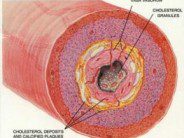This article was originally written in March of 1998 and appeared in RWJ Today during my first year of medical school. It is the second part of the Back to the Future series.
As humans age, the diameter of blood vessels becomes progressively smaller due to a process known as atherosclerosis. Atherosclerosis is thought to be caused by a sedentary lifestyle, stress, and a diet high in saturated fats. As the disease progresses, deposition of plaque on the interior of blood vessels causes their narrowing, which increases susceptibility to occlusion by a thrombus. When this occurs in the heart, myocardial infarction results because the myocardial cells downstream form the blockage become ischemic and die.
Coronary artery bypass graft (CABG) surgery is a method used to prevent this myocardial cell death by grafting a blood vessel around the blocked coronary artery and thus establishing an alternative route for blood flow. Biomedical researchers have tried for decades to stimulate collateral blood vessel growth so that CABG could be avoided, but only until recently have they made significant progress.
Dr. Ronald Crystal and his team at New York Hospital – Cornell Medical Center in New York are currently studying the feasibility of gene therapy to stimulate collateral blood vessel growth. These investigators have been injecting the gene for vascular endothelial growth factor (VEGF) into the hearts of patients with coronary artery blockages.
In addition to the gene therapy approach, Dr. Michael Simons and his team at Beth Israel Medical Center in Boston are trying to apply the VEGF protein directly to the hearts of patients. Other researchers are experimenting with a related growth factor called fibroblast growth factor (FGF). Recently, Dr. Thomas-Joseph Stregmann and his German team published their results regarding the efficacy of FGF in stimulating collateral blood vessel growth in the journal Circulation, which is published by the American Heart Association (AHA). In all 20 patients treated with the FGF protein, collateral artery growth was detectable days after injection. If other investigators find similar results, the new procedure may be tested in clinical trials before it can be used in the treatment of the general population.
Reference:
Altman, LK, “Injectable heart drug grows blood vessels.” New York Times, F7, February 24, 1998.










 DrSamGirgis.com is a blog about medicine, nutrition, health, wellness, and breaking medical news. At DrSamGirgis.com, the goal is to provide a forum for discussion on health and wellness topics and to provide the latest medical research findings and breaking medical news commentary.
DrSamGirgis.com is a blog about medicine, nutrition, health, wellness, and breaking medical news. At DrSamGirgis.com, the goal is to provide a forum for discussion on health and wellness topics and to provide the latest medical research findings and breaking medical news commentary.
{ 0 comments… add one now }